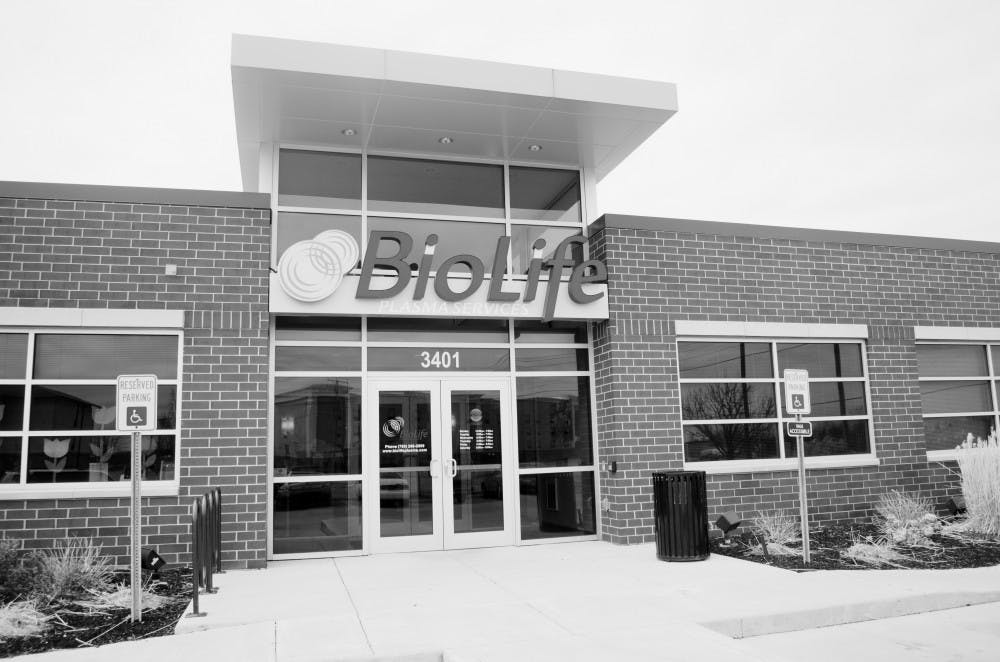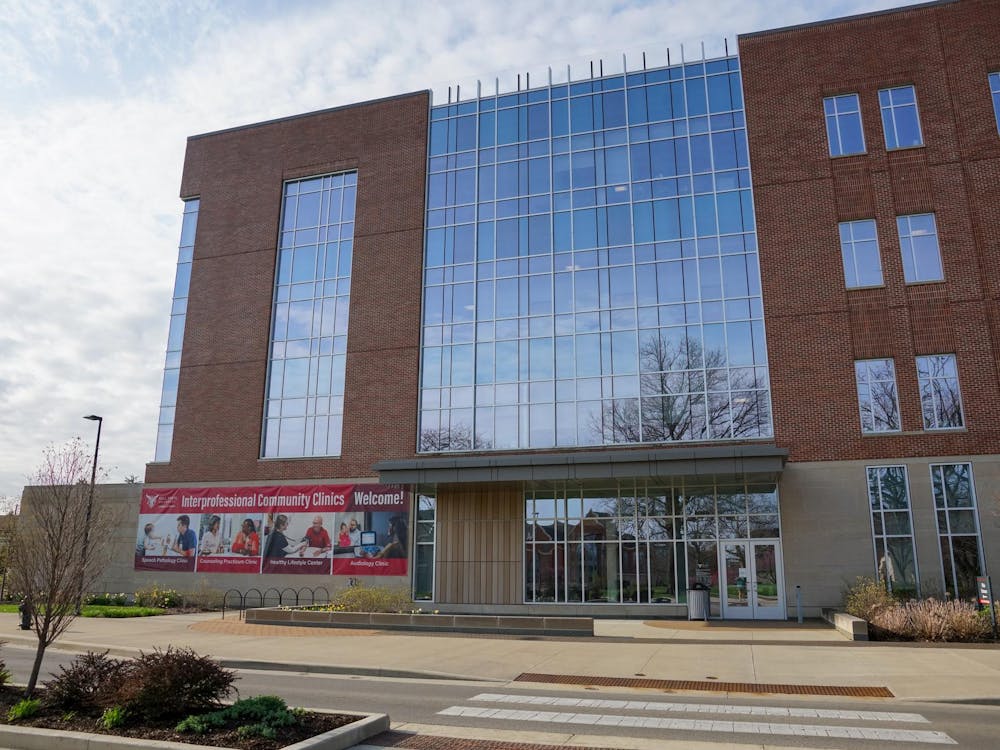Busy college students across the state are finding new and innovative ways to save and make extra cash to make ends meet.
Some collect and turn in recyclables. Some scrounge for quarters anywhere they can. Still more wait until they can’t bear it before turning on the air conditioner or heater.
Others sell their plasma.
After all, $70 a week earned while studying or relaxing can stretch pretty far.
Donating blood plasma is a quick and easy way to make extra money for bills. The risk, though, lies in the effects down the road for frequent donors.
The process is similar to donating whole blood, only with extra steps. A needle — larger than the one used for whole blood — is inserted into the vein, extracting blood. The platelets and red and white blood cells are separated from the plasma.
John Wilkins, an associate professor of anatomy and physiology, said whole blood is made up of about equal parts plasma and cells.
The plasma is collected and the rest of the blood is returned to the body. This is why the needle is bigger for plasma donations — the blood goes both ways.
Plasma contains a variety of useful proteins. Fibrinogen, for example, is a clotting factor which is useful for hemophiliacs or trauma victims, Wilkins said. Gamma globulin is a protein used to treat some viral diseases. Shots of gamma globulin, Wilkins said, provide an immediate boost to the body’s immune system — and do not come cheap.
“They advertise [plasma] as a life-saving product, and it truly is,” Wilkins said.
It takes a lot of plasma to treat the different diseases. It takes 1,237 plasma donations for one year of therapy for hemophilia and 943 donations for one year of therapy for Alpha-1 deficiency, a genetic disorder that can cause liver and lung disease, according to a report by the Plasma Protein Therapeutics Association.
A 2011 study by the Jefferson School of Population Health at Thomas Jefferson University found the average price paid to donation companies per unit of plasma was about $60. For two donations, that means the company makes $120 and gives the donor $70. Depending on what it is used for, though, one liter of plasma can go for as much as $500.
Plasma cannot be replicated in a lab or taken from animals, so it is always in demand.
And college students always seem to be in need of money. In Indiana, about 60 percent of college students not living with relatives live at or below the poverty line, according to the Census Bureau.
There are not many places where for about two hours twice a week, students can study or relax and make $70 to help combat that poverty.
In Indiana, 71 percent of universities have a paid plasma donation center within five miles of the main campus. Muncie’s BioLife center is a only 2.8 miles from Ball State, and Octapharma Plasma is 2.6 miles from Indiana University, South Bend.
BioLife’s press kit said most donors at their facilities come from within a seven-mile radius of a center. This puts Ball State, IPFW and Indiana University Kokomo right in the center of that radius.
With college campuses so close by, it is no wonder that up to 60 percent of plasma donors are students, according to the press kit.
At these centers, students can use breaks in their schedules that may be too short for a job to make money.
At BioLife Plasma Services center in Muncie, Alex Finney, a music education major, received $20 when he donated on a Monday. Going again later in the week, he would have received an additional $50, according to the center.
Finney said the money he makes donating plasma is just extra spending money for when he goes home.
For Bianca Polk, an elementary education major, the prepaid debit card from BioLife was her only income for a while until she found a job. She continued donating even when she was hired to make ends meet.
Jessa Merrill of Grifols, the parent company of such plasma centers as Talecris in Anderson, said Grifols considers “location, healthy donor populations and strong employee pools,” when looking for new donor sites. These qualities are typically found in college towns, she said.
Baxalta, the parent company of BioLife, did not respond to requests for comment.
Donating plasma is generally considered to be safe for both the donor and recipient. Before the plasma ever reaches a patient, it goes through extensive tests and treatments to screen for viruses like HIV in order to ensure those are not passed on to the recipient.
Donors, especially if it's their first time, are monitored throughout the process to make sure everything goes smoothly. They also get tested before they donate to determine blood pressure, iron levels and other important factors to make sure it is safe for them.
Donating plasma is how Ethan Hardwick, a music media production major, makes up for the hours he wasn’t getting from a job. It also went toward the engagement ring he bought.
Hardwick said one time when he came to the donation center right after playing racquetball, his pulse was too high when he was tested, so the phlebotomists had him sit down for a few minutes until he calmed down to an acceptable level for donation. High or low blood pressure and low iron levels can also disqualify a donor.
“Donating plasma is a low-risk procedure with minimal or no adverse effects,” Merrill said.
About 40 percent of plasma donors experience adverse effects. Although most are minimally dangerous, like feeling weak or dizzy, some can be more serious, like fainting. Donors are expected to eat and drink after donating, to help their bodies replenish lost nutrients.
There can be more serious side effects in the long run, as well. Because plasma contains immune and clotting proteins, Wilkins said regular donors can sometimes get sick easier or have problems with clotting.
“I did notice it was harder to keep from getting sick,” Hardwick said.
He said he got colds more often while he was donating, and he would become winded easier when climbing stairs.
Wilkins said the body usually replaces lost proteins relatively quickly, but in the meantime, frequent colds and issues like nosebleeds that are hard to stop are problems to look out for.
Donors are not allowed to donate more than once in a 48-hour period, and no more than twice in seven days. This means that those donating at BioLife in Muncie twice a week can make around $280 per month.
The United States is one of the only countries where donors can donate so frequently. In Europe, donors can donate up to twice each week, but are limited to 33 donations each year. The United States has no such yearly limits, according to the Plasma Protein Therapeutics Association.
Donating with such frequency, for many people, does not have many obvious side effects. However, after repeated insertions, the vein at the insertion point can sometimes become hard because of scar tissue.
Hardwick said a scar started to form on his arm after just a few weeks of donating. The last four months he donated, he said the scar tissue would hurt more when they inserted the needle.
That scar tissue has since healed in the year or so that Hardwick has not donated his plasma. The scar is still on his arm, though.
Long-term and frequent donations also can lower donors’ immune systems for an extended period.
Hardwick and Polk, when they donated, gave to the BioLife in Muncie twice each week pretty regularly, they said. Finney said he has only started donating, but plans to donate twice a week as well.
“You make more [money] that way,” Finney said about the increase from $20 for the first donation to $50 for the second.
The money is a great incentive for students to donate regularly.
“If it weren’t for the money, I probably wouldn’t have gone [to BioLife] the first time,” Polk said.
Now that she knows how important plasma is, Polk said she would donate, but it was the money that brought her in the doors in the first place.
A regular donor of whole blood, Hardwick said donating plasma disqualified him from donating whole blood, so he wouldn’t have donated plasma either if not for the money.
For those who do donate plasma, Wilkins recommends watching out for frequent nosebleeds and colds, which could be a sign of issues with clotting or the immune system. He also recommends taking a break from donating after three months or so to give the body a rest.





